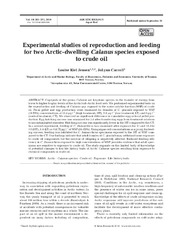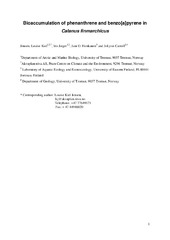| dc.contributor.advisor | Wassmann, Paul | |
| dc.contributor.author | Jensen, Louise Kiel | |
| dc.date.accessioned | 2012-01-11T09:23:00Z | |
| dc.date.available | 2012-01-11T09:23:00Z | |
| dc.date.issued | 2011-11-11 | |
| dc.description.abstract | Summary
Petroleum exploitation is emerging in the Arctic. In the Norwegian Arctic the southern Barents Sea is opened for development of oil and gas fields. This same area holds some of the world's largest and well managed commercial fish stocks such as Herring (Clupea harengus), Capelin (Mallotus villosus), Haddock (Melanogrammus aeglefinus), Atlantic Cod (Gadus morhua). For the interest of the fishing industry, as well as for maintaining a healthy ecosystem, petroleum related Environmental Risk Assessments (ERA) for the Barents Sea must be based on sound scientific knowledge of the special features of the Arctic ecosystem.
In colder areas the physical behavior of oil is different compared to warmer areas. The lower temperature and lack of sun light during the Arctic winter slows down the natural physical weathering process of oil. In ERA in temperate areas the effects of exposure to the most volatile fraction of the oil are neglected due to short exposure time. However, in the Arctic the exposure to biota of this volatile fraction may be prolonged due to lower evaporation rates and the volatile fraction may be an important contributor to the overall adverse effect of an oil spill. Likewise, the exposure to the heavier oil fractions may be prolonged and knowledge on the long-term effects of exposure is essential.
As an adaptation to the Arctic environment species found here have longer life spans, larger body sizes and higher lipid contents compared to temperate equivalent species. Thus Arctic species may accumulate contaminants over longer time and reach higher life time body levels. Meanwhile higher lipid content implies a higher affinity of lipophilic contaminants such as polycyclic aromatic hydrocarbons (PAHs). So, Arctic species may be exposed to oil compounds for a longer time because of the prolonged phycical presence and may, due to special adaptive features, be more efficient at accumulating oil contaminants.
Today the knowledge of effects of oil contaminants on Arctic biota is limited, but growing. This thesis addresses a few of the research challenges in the field and provides knowledge on some effects of petroleum exposure to two copepod species; the sub-Arctic Calanus finmarchicus and the Arctic sibling species C. glacialis. First, Calanus was cultured for a generations under sub-Arctic conditions (Paper I). This work establishes that Calanus is suitable for ecological relevant long-term experiments. In an oil spill scenario, Arctic copepods and algae may be exposed to the more volatile fraction of the oil. Paper II provides data showing that the Arctic diatom species, Fragilariopsis oceanica, was the most sensitive species to exposure to the volatile hydrocarbon xylene. Further, the smaller, less lipid rich copepod species C. finmarchicus, was more sensitive compared to the true Arctic C. glacialis. Extrapolating these results to a spill situation, C. finmarchicus and C. glacialis populations would be affected by xylene exposure through both direct exposure (mortality) and indirectly through a decline in prey organisms (algae).
Sub-lethal effects after long-term exposures to low concentrations of oil compounds may also be detected in C. finmarchicus and C. glacialis. Feeding was suppressed in C. finmarchicus after exposure to 7.0 µg PAHs l-1 for 11 days (Paper III). No significant effect on feeding was detected in C. glacialis exposed to 10.4 µg PAHs l-1 for 11 days. However, the hatching success of eggs laid by females exposed to 10.4 µg PAHs l-1 for two days was significantly reduced (Paper III).
The long term effects of lipophilic PAHs in biota depend on the bioaccumulation capacity and internal concentrations of the various PAHs. Accumulation of lipophilic compounds is particularly important for the lipid rich Arctic species. Paper IV examines the uptake kinetics of two PAHs in C. finmarchicus and show that the accumulation of the lighter and less lipophilic compound, phenanthrene, is faster that the uptake of the heavier and more lipophilic benzo[a]pyrene (B[a]P). Equilibrium was reached for phenanthrene within 192 h exposure while no equilibrium was detected for B[a]P. The bioconcentration factor (BCF) was higher for B[a]P, reflecting the higher affinity for lipids of B[a]P compared to phenanthrene (Paper IV). So the heavier, more lipophilic PAH accumulates slower but to a higher concentration in C. finmarchicus.
This thesis shows that not only acute but also long-term exposures may affect Arctic species. In addition, exposure duration may determine which compounds are accumulated by biota. Both indirect effects, such as decrease of food items, and direct effects, such as mortality, reduced feeding and reproduction failure may have implications for population development. These findings should be taken into consideration when developing ERA for the Barents Sea area. | en |
| dc.description.doctoraltype | ph.d. | en |
| dc.description.popularabstract | Der er i dag økt interesse for oljeutvinning i arktiske områder og flere oljefelt skal settes i produksjon i Barentshavet. Samtidig er Barentshavet et rikt økosystem med mange velforvaltede fiskepopulasjoner. For å minimere interessekonflikter må det utarbeides miljømessige risikoanalyser for Barentshavet. På grunn av arktiske arters særegenheter mistenkes at disse reagerer annerledes på eksponering for olje enn sørlige arter, men dette er lite undersøkt i dag.
Arktiske arter lever lengere, blir større og inneholder mer lipider enn deres sørlige søsterarter. Ved oljeforurensing vil det finnes skadelige stoffer som bindes i organismene og da særlig til lipider i disse. Derfor mistenkes det at arktiske arter vil reagerer annerledes på oljeforurensing sammenlignet med sørlige arter. Samtidig vil eksponeringen til oljen kunne vare lengre i arktiske områder fordi den fysiske nedbrytingenav oljen her er langsommere enn lengre sør.
Med utgangspunkt i to nært beslektede hoppekrepsarter, den sub-arktiske Calanus finmarchicus og den arktiske C. glacialis, er forskjellige effekter av oljeeksponering undersøkt i laboratorieforsøk. Her vises det at korttidseksponering til flyktige stoffer i oljen vil kunne gi forhøyet dødelighet, og av de to hoppekrepsartene, er det den sørlige og minst lipidrike som er mest sensitiv. Videre er der gjennomført langtidseksponeringer på hoppekrepsene, hvor det vises at ikke-dødelige effekter induseres av lave doser av olje. Et tredje forsøk viser at opptaket i C. finmarchicus av de forskjellige bestandele av oljen er avhengig av stoffernes tiltrekning til olje. | en |
| dc.description.sponsorship | Norwegian Research Council PROOF programme (Project No. 157649) (awarded to J. Carroll)
The Statoil-ARCTOS Arctic Research Program (SAARP)
"Arktisk stipend" from Svalbard Science Forum Akvaplan niva. | en |
| dc.description | Papers 1 and 2 of this thesis are not available in Munin: <br/>1. Jensen, L.K., Carroll, JL., Pedersen, G., Hylland, K., Dahle, S. and Bakke, T.: 'A multigeneration Calanus finmarchicus culturing system for use in long-term oil exposure experiments', Journal of Experimental Marine Biology and Ecology (2006) 333: 71-78. Available at <a href=http://dx.doi.org/10.1016/j.jembe.2005.12.001>http://dx.doi.org/10.1016/j.jembe.2005.12.001</a> <br/>2. Jensen, L.K. and Carroll, JL.: 'Effects of the volatile petroleum component xylene on Arctic algae and zooplankton' (submitted manuscript to Marine Environmental Research). | en |
| dc.identifier.isbn | 978-82-8266-017-4 | |
| dc.identifier.uri | https://hdl.handle.net/10037/3794 | |
| dc.identifier.urn | URN:NBN:no-uit_munin_3505 | |
| dc.language.iso | eng | en |
| dc.publisher | University of Tromsø | en |
| dc.rights.accessRights | openAccess | |
| dc.rights.holder | Copyright 2011 The Author(s) | |
| dc.rights.uri | https://creativecommons.org/licenses/by-nc-sa/3.0 | en_US |
| dc.rights | Attribution-NonCommercial-ShareAlike 3.0 Unported (CC BY-NC-SA 3.0) | en_US |
| dc.subject | VDP::Matematikk og Naturvitenskap: 400::Zoologiske og botaniske fag: 480::Økotoksikologi: 489 | en |
| dc.subject | VDP::Mathematics and natural science: 400::Zoology and botany: 480::Ecotoxicology: 489 | en |
| dc.title | Acute and long-term effects from petroleum discharges on temperate and Arctic Calanus species | en |
| dc.type | Doctoral thesis | en |
| dc.type | Doktorgradsavhandling | en |


 English
English norsk
norsk


